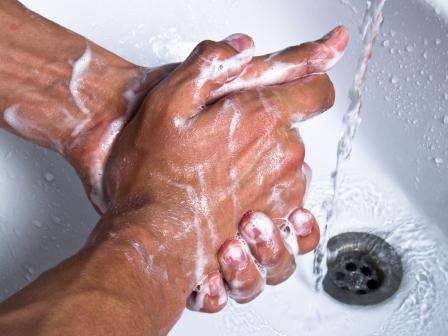Does Soap Really Kill 99.9% of Germs?
Does soap really kill germs like it’s supposed to?

What is a clean freak to do? How can we possibly combat all of those germs? This question comes from listener Geraldo in Brazil and I think it’s a great one. Does soap really kill 99.9% of germs?
How Does Soap Clean?
Remember that a germ is what we call any microscopic particle or organism that can make us sick, so this includes viruses and bacteria. Most of the gunk we want to wash off of our hands, whether it be dirt or germs, adheres to us thanks to the oils on our skin. Destroying the oil with a solvent like alcohol or kerosene will thus remove the associated germs.
However, although soaps used in hospitals are often strong, alcohol based versions, alcohol and kerosene are themselves toxic to varying degrees and thus not ideal for frequent in-home use. Imagine smelling like kerosene all day? Luckily, we have soap.
Rather than dissolve oil, soap molecules work in a more mechanical way to essentially convince the oil particles (and thus their associated germs) to join up with water molecules so that they can be more readily washed away. Each soap molecule typically looks like a long chain of carbon and hydrogen atoms with one end that readily joins water molecules (called the hydrophilic end). The other end of the soap molecule prefers to avoid water (called the hydrophobic end) and instead happily attaches to grease.
Thus, when you are washing your hands, the hydrophobic end grabs on to the germ-hosting oil particles, while the other, hydrophilic end coaxes the oil toward the water to eventually be flushed away.
In fact, to remove themselves from water as much as possible, the hydrophobic ends of soap molecules will even force their way between water molecules on any surface. By forcing the water molecules apart, soap effectively reduces the surface tension. You can test this by filling a glass of water just to the brink of spilling. Surface tension of the water will keep the overfull glass from spilling over until you drop a bit of soap on top or tap it with a soapy finger which both cause the water to immediately spill out.
Is There Truth in Advertising?
So do soaps really kill 99.9% of germs? Claiming just short of 100% may seem like an attempt to fall into a legal loophole (i.e. if we don’t claim to kill all germs then no one can sue us!) but they are actually based on lab results. However, the tests that prove 99.9% effectiveness are conducted by the soap manufacturers themselves under laboratory conditions. Typically, bacteria are placed on an otherwise clean surface, that surface is wiped down with the soap, and then any bacteria that remain are monitored and recorded.
Obviously, these conditions are a far cry from the messiness of everyday life and are based on a thorough, complete scrubbing. And that claim of 99.9% could refer only to more common germs or some other subset. In a study that looked at the hand washing practices of eighth graders in Hamilton, Ontario, researchers found a typical hand washing removed between 46-60% of germs. And again, washing our hands isn’t really killing those germs but rather washing them away.
Also, let’s look at even the best case scenario where soap does kill 99.9% of all of the germs on your hand every time you wash. The remaining 0.1% may sound insignificant, but 0.1% of a lot is, well, still a lot.
Let’s look back at the example of our filthy cell phones. The Oatmeal has a quiz you can take (with adorably disgusting and comical germy illustrations, of course) to estimate how many germs are on your cell phone specifically, based on factors like how often you clean your phone, where you keep your phone when you’re not using it, how often you wash your hands, and how much time you spend around sick people or children. Based on my answers, they estimate that there are 2,516,640 germs living on my cell phone right now, the equivalent of 503 toilet seats. Gross!
Even grosser, if I washed my hands and phone with a soap that has 99.9% germ killing capabilities, I am still left with about 2,500 germs, more than are estimated to live in my dog’s water dish. I think I’ve got some cleaning to do.
For another interesting look at just how many microbes we come into contact on a daily basis, check out the image shared by Dr. Tasha Sturm of Cabrillo College of the microbes living on her son’s hand after an afternoon of playing outside. That’s what happens when mom is a microbiologist!
Until next time, this is Sabrina Stierwalt with Ask Science’s Quick and Dirty Tips for helping you make sense of science. You can become a fan of Ask Science on Facebook or follow me on Twitter, where I’m @QDTeinstein. If you have a question that you’d like to see on a future episode, send me an email at everydayeinstein@quickanddirtytips.comcreate new email.






